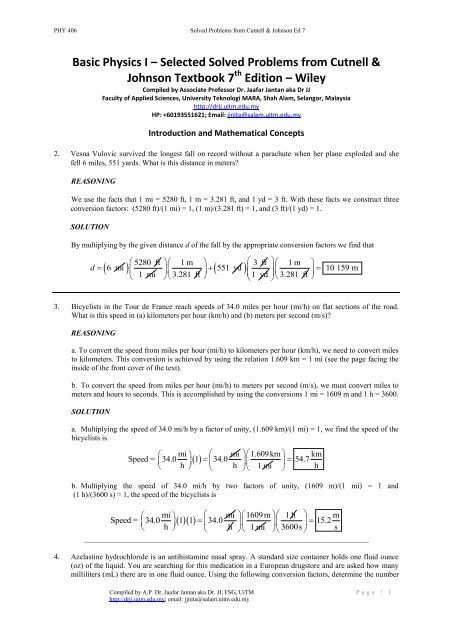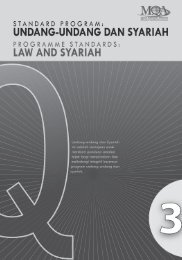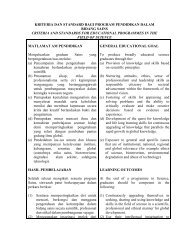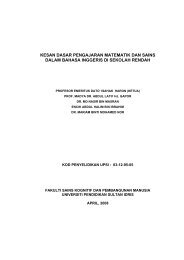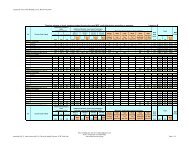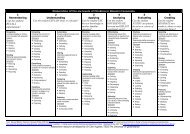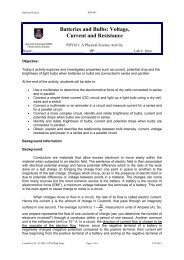Solved Problems from Cutnell-Johnson - Dr. Jaafar Jantan - UiTM
Solved Problems from Cutnell-Johnson - Dr. Jaafar Jantan - UiTM
Solved Problems from Cutnell-Johnson - Dr. Jaafar Jantan - UiTM
You also want an ePaper? Increase the reach of your titles
YUMPU automatically turns print PDFs into web optimized ePapers that Google loves.
PHY 406 <strong>Solved</strong> <strong>Problems</strong> <strong>from</strong> <strong>Cutnell</strong> & <strong>Johnson</strong> Ed 7<br />
Basic Physics I – Selected <strong>Solved</strong> <strong>Problems</strong> <strong>from</strong> <strong>Cutnell</strong> &<br />
<strong>Johnson</strong> Textbook 7 th Edition – Wiley<br />
Compiled by Associate Professor <strong>Dr</strong>. <strong>Jaafar</strong> <strong>Jantan</strong> aka <strong>Dr</strong> JJ<br />
Faculty of Applied Sciences, University Teknologi MARA, Shah Alam, Selangor, Malaysia<br />
http://drjj.uitm.edu.my<br />
HP: +60193551621; Email: jjnita@salam.uitm.edu.my<br />
Introduction and Mathematical Concepts<br />
2. Vesna Vulovic survived the longest fall on record without a parachute when her plane exploded and she<br />
fell 6 miles, 551 yards. What is this distance in meters?<br />
REASONING<br />
We use the facts that 1 mi = 5280 ft, 1 m = 3.281 ft, and 1 yd = 3 ft. With these facts we construct three<br />
conversion factors: (5280 ft)/(1 mi) = 1, (1 m)/(3.281 ft) = 1, and (3 ft)/(1 yd) = 1.<br />
SOLUTION<br />
By multiplying by the given distance d of the fall by the appropriate conversion factors we find that<br />
5280 ft <br />
1 m <br />
d 6 mi <br />
551<br />
yd<br />
1 mi 3.281<br />
ft <br />
<br />
Compiled by A.P. <strong>Dr</strong>. <strong>Jaafar</strong> <strong>Jantan</strong> aka <strong>Dr</strong>. JJ, FSG, <strong>UiTM</strong><br />
http://drjj.uitm.edu.my; email: jjnita@salam.uitm.edu.my<br />
3 ft <br />
1 m <br />
<br />
1 yd <br />
<br />
3.281<br />
ft <br />
10 159 m<br />
3. Bicyclists in the Tour de France reach speeds of 34.0 miles per hour (mi/h) on flat sections of the road.<br />
What is this speed in (a) kilometers per hour (km/h) and (b) meters per second (m/s)?<br />
REASONING<br />
a. To convert the speed <strong>from</strong> miles per hour (mi/h) to kilometers per hour (km/h), we need to convert miles<br />
to kilometers. This conversion is achieved by using the relation 1.609 km = 1 mi (see the page facing the<br />
inside of the front cover of the text).<br />
b. To convert the speed <strong>from</strong> miles per hour (mi/h) to meters per second (m/s), we must convert miles to<br />
meters and hours to seconds. This is accomplished by using the conversions 1 mi = 1609 m and 1 h = 3600.<br />
SOLUTION<br />
a. Multiplying the speed of 34.0 mi/h by a factor of unity, (1.609 km)/(1 mi) = 1, we find the speed of the<br />
bicyclists is<br />
mi mi 1.609km<br />
Speed = 34.0134.0 <br />
h h <br />
1 mi <br />
km<br />
54.7 h<br />
b. Multiplying the speed of 34.0 mi/h by two factors of unity, (1609 m)/(1 mi) = 1 and<br />
(1 h)/(3600 s) = 1, the speed of the bicyclists is<br />
mi mi 1609m<br />
1h m<br />
Speed = 34.01134.0 <br />
15.2<br />
h h <br />
1 mi 3600s<br />
s<br />
___________________________________________________________________________<br />
4. Azelastine hydrochloride is an antihistamine nasal spray. A standard size container holds one fluid ounce<br />
(oz) of the liquid. You are searching for this medication in a European drugstore and are asked how many<br />
milliliters (mL) there are in one fluid ounce. Using the following conversion factors, determine the number<br />
P a g e | 1
PHY 406 <strong>Solved</strong> <strong>Problems</strong> <strong>from</strong> <strong>Cutnell</strong> & <strong>Johnson</strong> Ed 7<br />
of milliliters in a volume of one fluid ounce: ,<br />
REASONING<br />
, and .<br />
Multiplying an equation by a factor of 1 does not alter the equation; this is the basis of our solution. We<br />
will use factors of 1 in the following forms:<br />
SOLUTION<br />
1 gal<br />
1,<br />
since 1 gal = 128 oz<br />
128 oz<br />
3<br />
3<br />
, since 3.785 10 3 m 3 = 1 gal<br />
3.78510 m<br />
1<br />
1 gal<br />
1 mL<br />
6<br />
3<br />
10 m<br />
The starting point for our solution is the fact that<br />
1,<br />
since 1 mL = 10 6 m 3<br />
Volume = 1 oz<br />
Multiplying this equation on the right by factors of 1 does not alter the equation, so it follows that<br />
1 gal 3<br />
3<br />
3.78510 m <br />
1 mL <br />
Volume 1 oz1 11 1 oz <br />
<br />
29.6<br />
mL<br />
128 oz <br />
1 gal <br />
6<br />
3<br />
10 m<br />
<br />
<br />
Note that all the units on the right, except one, are eliminated algebraically, leaving only the desired units<br />
of milliliters (mL).<br />
5. The mass of the parasitic wasp Caraphractus cintus can be as small as . What is this mass in<br />
(a) grams (g), (b) milligrams (mg), and (c) micrograms (μg)?<br />
REASONING<br />
When converting between units, we write down the units explicitly in the calculations and treat them like<br />
any algebraic quantity. We construct the appropriate conversion factor (equal to unity) so that the final<br />
result has the desired units.<br />
SOLUTION<br />
a. Since grams = 1.0 kilogram, it follows that the appropriate conversion factor is . Therefore,<br />
b. Since milligrams = 1.0 gram,<br />
c. Since micrograms = 1.0 gram,<br />
6<br />
510 kg <br />
3<br />
1.010 g <br />
3<br />
<br />
510 g<br />
1.0 kg <br />
<br />
3<br />
3<br />
1.010 mg <br />
510 g <br />
1.0 g <br />
<br />
Compiled by A.P. <strong>Dr</strong>. <strong>Jaafar</strong> <strong>Jantan</strong> aka <strong>Dr</strong>. JJ, FSG, <strong>UiTM</strong><br />
http://drjj.uitm.edu.my; email: jjnita@salam.uitm.edu.my<br />
5 mg<br />
P a g e | 2
PHY 406 <strong>Solved</strong> <strong>Problems</strong> <strong>from</strong> <strong>Cutnell</strong> & <strong>Johnson</strong> Ed 7<br />
3<br />
510 g <br />
6<br />
1.010 g<br />
<br />
3<br />
<br />
510g 1.0 g <br />
<br />
8. The volume of liquid flowing per second is called the volume flow rate Q and has the dimensions of<br />
[L] 3 /[T]. The flow rate of a liquid through a hypodermic needle during an injection can be estimated with<br />
the following equation:<br />
The length and radius of the needle are L and R, respectively, both of which have the dimension [L]. The<br />
pressures at opposite ends of the needle are P2 and P1, both of which have the dimensions of [M]/{[L]<br />
[T] 2 }. The symbol ή represents the viscosity of the liquid and has the dimensions of [M]/{[L][T]}. The<br />
symbol π stands for pi and, like the number 8 and the exponent n, has no dimensions. Using dimensional<br />
analysis, determine the value of n in the expression for Q<br />
REASONING<br />
In the expression for the volume flow rate, the dimensions on the left side of the equals sign are [L] 3 /[T].<br />
If the expression is to be valid, the dimensions on the right side of the equals sign must also be [L] 3 /[T].<br />
Thus, the dimensions for the various symbols on the right must combine algebraically to yield [L] 3 /[T].<br />
We will substitute the dimensions for each symbol in the expression and treat the dimensions of [M], [L],<br />
and [T] as algebraic variables, solving the resulting equation for the value of the exponent n.<br />
SOLUTION<br />
We begin by noting that the symbol and the number 8 have no dimensions. It follows, then, that<br />
Thus, we find that n = 4 .<br />
n<br />
3<br />
2 1<br />
L or<br />
8LT R P P<br />
Q <br />
3 n<br />
L L <br />
T LT n<br />
L L n M L 2<br />
LT M <br />
L L<br />
T<br />
Compiled by A.P. <strong>Dr</strong>. <strong>Jaafar</strong> <strong>Jantan</strong> aka <strong>Dr</strong>. JJ, FSG, <strong>UiTM</strong><br />
http://drjj.uitm.edu.my; email: jjnita@salam.uitm.edu.my<br />
<br />
2<br />
LT <br />
LT n n<br />
L T L<br />
<br />
<br />
3 3 4<br />
or L or L L L L<br />
9. The depth of the ocean is sometimes measured in fathoms . Distance on the surface<br />
of the ocean is sometimes measured in nautical miles . The water beneath<br />
a surface rectangle 1.20 nautical miles by 2.60 nautical miles has a depth of 16.0 fathoms. Find the volume<br />
of water (in cubic meters) beneath this rectangle.<br />
REASONING<br />
The volume of water at a depth d beneath the rectangle is equal to the area of the rectangle multiplied by d.<br />
The area of the rectangle = (1.20 nautical miles) (2.60 nautical miles) = 3.12 (nautical miles) 2 . Since<br />
6076 ft = 1 nautical mile and 0.3048 m = , the conversion factor between nautical miles and meters is<br />
n<br />
P a g e | 3
PHY 406 <strong>Solved</strong> <strong>Problems</strong> <strong>from</strong> <strong>Cutnell</strong> & <strong>Johnson</strong> Ed 7<br />
SOLUTION<br />
6076 ft 0.3048 m 1.85210 m<br />
<br />
1 nautical mile 1 ft 1 nautical mile<br />
The area of the rectangle of water in m 2 is, therefore,<br />
3<br />
2<br />
2 <br />
1.85210 m <br />
<br />
<br />
3.12 (nautical miles)<br />
<br />
<br />
1 nautical mile <br />
<br />
Since 1 fathom = 6 ft, and 1 ft = 0.3048 m, the depth d in meters is<br />
Compiled by A.P. <strong>Dr</strong>. <strong>Jaafar</strong> <strong>Jantan</strong> aka <strong>Dr</strong>. JJ, FSG, <strong>UiTM</strong><br />
http://drjj.uitm.edu.my; email: jjnita@salam.uitm.edu.my<br />
3<br />
7 2<br />
1.07 10 m<br />
6 ft 0.3048<br />
m <br />
1<br />
16.0 fathoms <br />
=<br />
2.93 10<br />
m<br />
1 fathom <br />
1 ft <br />
The volume of water beneath the rectangle is<br />
(1.07 10 7 m 2 ) (2.93 10 1 m) =<br />
__________________________________________________________________________________________<br />
10. A spring is hanging down <strong>from</strong> the ceiling, and an object of mass m is attached to the free end. The object<br />
is pulled down, thereby stretching the spring, and then released. The object oscillates up and down, and the<br />
time T required for one complete up-and-down oscillation is given by the equation , where<br />
k is known as the spring constant. What must be the dimension of k for this equation to be dimensionally<br />
correct?<br />
REASONING<br />
The dimension of the spring constant k can be determined by first solving the equation T 2 m/ k<br />
for k in terms of the time T and the mass m. Then, the dimensions of T and m can be substituted into this<br />
expression to yield the dimension of k.<br />
SOLUTION<br />
2 2<br />
2<br />
Algebraically solving the expression above for k gives k 4 m/ T . The term 4 is a numerical<br />
factor that does not have a dimension, so it can be ignored in this analysis. Since the dimension for mass is<br />
[M] and that for time is [T], the dimension of k is<br />
Dimension of k <br />
<br />
2<br />
M<br />
T<br />
P a g e | 4
PHY 406 <strong>Solved</strong> <strong>Problems</strong> <strong>from</strong> <strong>Cutnell</strong> & <strong>Johnson</strong> Ed 7<br />
KINEMATICS IN ONE DIMENSION<br />
4. An 18-year-old runner can complete a 10.0-km course with an average speed of 4.39 m/s. A 50-year-old<br />
runner can cover the same distance with an average speed of 4.27 m/s. How much later (in seconds) should<br />
the younger runner start in order to finish the course at the same time as the older runner?<br />
REASONING<br />
The younger (and faster) runner should start the race after the older runner, the delay being the difference<br />
between the time required for the older runner to complete the race and that for the younger runner. The<br />
time for each runner to complete the race is equal to the distance of the race divided by the average speed<br />
of that runner (see Equation 2.1).<br />
SOLUTION<br />
The difference in the times for the two runners to complete the race is t50 t18<br />
, where<br />
Distance Distance<br />
t and t (2.1)<br />
Average Speed Average Speed<br />
50 18<br />
50-yr-old 18-yr-old<br />
The difference in these two times (which is how much later the younger runner should start) is<br />
Distance Distance<br />
t t <br />
50 18<br />
Average Speed Average Speed<br />
Compiled by A.P. <strong>Dr</strong>. <strong>Jaafar</strong> <strong>Jantan</strong> aka <strong>Dr</strong>. JJ, FSG, <strong>UiTM</strong><br />
http://drjj.uitm.edu.my; email: jjnita@salam.uitm.edu.my<br />
50-yr-old 18-yr-old<br />
3 3<br />
<br />
10.010 m<br />
4.27 m/s<br />
<br />
10.010 m<br />
4.39 m/s<br />
64 s<br />
___________________________________________________________________________<br />
5. The Space Shuttle travels at a speed of about 7.6 × 10 3 m/s. The blink of an astronaut’s eye lasts about 110<br />
ms. How many football fields (length = 91.4 m) does the Shuttle cover in the blink of an eye?<br />
REASONING<br />
The distance traveled by the Space Shuttle is equal to its speed multiplied by the time. The number of<br />
football fields is equal to this distance divided by the length L of one football field.<br />
SOLUTION The number of football fields is<br />
3 3<br />
7.610 m / s110 10s<br />
x vt<br />
Number = <br />
L L<br />
91.4 m<br />
9.1<br />
___________________________________________________________________________<br />
6. The three-toed sloth is the slowest moving land mammal. On the ground, the sloth moves at an average<br />
speed of 0.037 m/s, considerably slower than the giant tortoise, which walks at 0.076 m/s. After 12<br />
minutes of walking, how much further would the tortoise have gone relative to the sloth?<br />
REASONING AND SOLUTION<br />
In 12 minutes the sloth travels a distance of<br />
60 s <br />
xs = vst= (0.037 m/s)(12 min) = 27 m<br />
1 min <br />
P a g e | 5
PHY 406 <strong>Solved</strong> <strong>Problems</strong> <strong>from</strong> <strong>Cutnell</strong> & <strong>Johnson</strong> Ed 7<br />
while the tortoise travels a distance of<br />
60 s <br />
xt = vtt<br />
= (0.076 m/s)(12 min) = 55 m<br />
1 min <br />
The tortoise goes farther than the sloth by an amount that equals 55 m – 27 m = 28 m<br />
___________________________________________________________________________<br />
7. A tourist being chased by an angry bear is running in a straight line toward his car at a speed of 4.0 m/s.<br />
The car is a distance d away. The bear is 26 m behind the tourist and running at 6.0 m/s. The tourist reaches<br />
the car safely. What is the maximum possible value for d?<br />
REASONING<br />
In order for the bear to catch the tourist over the distance d, the bear must reach the car at the same time as<br />
the tourist. During the time t that it takes for the tourist to reach the car, the bear must travel a total<br />
distance of d + 26 m. From Equation 2.1,<br />
v<br />
tourist<br />
d<br />
(1) and<br />
d 26 m<br />
vbear<br />
(2)<br />
t<br />
t<br />
Equations (1) and (2) can be solved simultaneously to find d.<br />
SOLUTION<br />
Solving Equation (1) for t and substituting into Equation (2), we find<br />
Solving for d yields:<br />
v<br />
bear<br />
d 26 m ( d 26 m) v<br />
<br />
d / v d<br />
tourist<br />
26 m <br />
v 1 v<br />
d <br />
bear tourist<br />
26 m 26 m<br />
d <br />
vbear<br />
6.0 m/s<br />
1<br />
1<br />
v 4.0 m/s<br />
tourist<br />
Compiled by A.P. <strong>Dr</strong>. <strong>Jaafar</strong> <strong>Jantan</strong> aka <strong>Dr</strong>. JJ, FSG, <strong>UiTM</strong><br />
http://drjj.uitm.edu.my; email: jjnita@salam.uitm.edu.my<br />
tourist<br />
52 m<br />
___________________________________________________________________________<br />
8. In reaching her destination, a backpacker walks with an average velocity of 1.34 m/s, due west. This<br />
average velocity results because she hikes for 6.44 km with an average velocity of 2.68 m/s, due west,<br />
urns around, and hikes with an average velocity of 0.447 m/s, due east. How far east did she walk?<br />
REASONING AND SOLUTION<br />
Let west be the positive direction. The average velocity of the backpacker is<br />
x x x x<br />
v w e where t w and t e<br />
t t w v e v<br />
w e w e<br />
Combining these equations and solving for x e (suppressing the units) gives<br />
P a g e | 6
PHY 406 <strong>Solved</strong> <strong>Problems</strong> <strong>from</strong> <strong>Cutnell</strong> & <strong>Johnson</strong> Ed 7<br />
x<br />
e<br />
<br />
1– v/ v <br />
e<br />
<br />
1– 1.34 m/s / 0.447 m/s<br />
– 1– v / vw xw<br />
– 1– 1.34 m/s / 2.68 m/s 6.44 km<br />
<br />
<br />
–0.81 km<br />
The distance traveled is the magnitude of x e , or 0.81 km .<br />
______________________________________________________________________________<br />
9. A bicyclist makes a trip that consists of three parts, each in the same direction (due north) along a straight<br />
road. During the first part, she rides for 22 minutes at an average speed of 7.2 m/s. During the second part,<br />
she rides for 36 minutes at an average speed of 5.1 m/s. Finally, during the third part, she rides for 8.0<br />
minutes at an average speed of 13 m/s. (a) How far has the bicyclist traveled during the entire trip? (b)<br />
What is her average velocity for the trip?<br />
REASONING AND SOLUTION<br />
a. The total displacement traveled by the bicyclist for the entire trip is equal to the sum of the<br />
displacements traveled during each part of the trip. The displacement traveled during each part of the<br />
trip is given by Equation 2.2: x v t . Therefore,<br />
60 s <br />
x1 (7.2 m/s)(22 min) 9500<br />
m<br />
1 min <br />
60 s <br />
x2 (5.1 m/s)(36 min) 11<br />
000 m<br />
1 min <br />
60 s <br />
x3 (13 m/s)(8.0 min) 6200<br />
m<br />
1 min <br />
The total displacement traveled by the bicyclist during the entire trip is then<br />
x 9500 m 11 000 m 6200 m 2.67 10 m<br />
b. The average velocity can be found <strong>from</strong> Equation 2.2.<br />
x2.6710 m 1min v 6.74 m/s, due north<br />
t 22 min 36 min 8.0 min <br />
60 s <br />
___________________________________________________________________________<br />
Compiled by A.P. <strong>Dr</strong>. <strong>Jaafar</strong> <strong>Jantan</strong> aka <strong>Dr</strong>. JJ, FSG, <strong>UiTM</strong><br />
http://drjj.uitm.edu.my; email: jjnita@salam.uitm.edu.my<br />
4<br />
10. A golfer rides in a golf cart at an average speed of 3.10 m/s for 28.0 s. She then gets out of the cart and<br />
starts walking at an average speed of 1.30 m/s. For how long (in seconds) must she walk if her average<br />
speed for the entire trip, riding and walking, is 1.80 m/s?<br />
REASONING<br />
The time t trip to make the entire trip is equal to the time t cart that the golfer rides in the golf cart plus the<br />
time t walk that she walks; t trip = t cart + t walk . Therefore, the time that she walks is<br />
t walk = t trip t cart (1)<br />
The average speed v trip<br />
for the entire trip is equal to the total distance, xcart + xwalk , she travels divided<br />
by the time to make the entire trip (see Equation 2.1);<br />
v<br />
trip<br />
x x<br />
<br />
t<br />
cart walk<br />
trip<br />
4<br />
P a g e | 7
PHY 406 <strong>Solved</strong> <strong>Problems</strong> <strong>from</strong> <strong>Cutnell</strong> & <strong>Johnson</strong> Ed 7<br />
Solving this equation for t trip and substituting the resulting expression into Equation 1 yields<br />
cart walk<br />
walk cart<br />
vtrip<br />
Compiled by A.P. <strong>Dr</strong>. <strong>Jaafar</strong> <strong>Jantan</strong> aka <strong>Dr</strong>. JJ, FSG, <strong>UiTM</strong><br />
http://drjj.uitm.edu.my; email: jjnita@salam.uitm.edu.my<br />
x x<br />
t t<br />
(2)<br />
The distance traveled by the cart is xcart vcartt , and the distance walked by the golfer is<br />
cart<br />
xwalk vwalkt . Substituting these expressions for x<br />
walk<br />
cart and xwalk into Equation 2 gives<br />
t<br />
v t v t<br />
t t<br />
cart cart walk walk<br />
walk cart<br />
vtrip<br />
The unknown variable t walk appears on both sides of this equation. Algebraically solving for this variable<br />
gives<br />
SOLUTION<br />
t<br />
walk<br />
The time that the golfer spends walking is<br />
walk<br />
v t v t<br />
<br />
v v<br />
cart cart trip cart<br />
trip walk<br />
vcarttcart vtriptcart 3.10 m/s 28.0 s 1.80 m/s 28.0 s<br />
<br />
v v 1.80 m/s 1.30<br />
m/s<br />
trip walk<br />
12. A sprinter explodes out of the starting block with an acceleration of +2.3 m/s 2 , which she sustains for 1.2 s.<br />
Then, her acceleration drops to zero for the rest of the race. What is her velocity (a) at t = 1.2 s and (b) at<br />
the end of the race?<br />
REASONING<br />
We can use the definition of average acceleration / tt <br />
0 0<br />
sprinter’s final velocity v at the end of the acceleration phase, because her initial velocity ( v 0 0 m/s ,<br />
73 s<br />
a v v (Equation 2.4) to find the<br />
since she starts <strong>from</strong> rest), her average acceleration a , and the time interval t t 0 are known.<br />
SOLUTION<br />
a. Since the sprinter has a constant acceleration, it is also equal to her average acceleration, so<br />
2<br />
a 2.3<br />
m/s Her velocity at the end of the 1.2-s period is<br />
2<br />
t t<br />
<br />
v v0 a 0 0 m/s 2.3 m/s 1.2 s 2.8<br />
m/s<br />
b. Since her acceleration is zero during the remainder of the race, her velocity remains constant at<br />
2.8 m/s .<br />
______________________________________________________________________________<br />
13. A motorcycle has a constant acceleration of 2.5 m/s 2 . Both the velocity and acceleration<br />
of the motorcycle point in the same direction. How much time is required for the<br />
motorcycle to change its speed <strong>from</strong> (a) 21 to 31 m/s, and (b) 51 to 61 m/s?<br />
P a g e | 8
PHY 406 <strong>Solved</strong> <strong>Problems</strong> <strong>from</strong> <strong>Cutnell</strong> & <strong>Johnson</strong> Ed 7<br />
REASONING<br />
Since the velocity and acceleration of the motorcycle point in the same direction, their numerical values<br />
will have the same algebraic sign. For convenience, we will choose them to be positive. The velocity,<br />
acceleration, and the time are related by Equation 2.4:<br />
SOLUTION<br />
a. Solving Equation 2.4 for t we have<br />
Compiled by A.P. <strong>Dr</strong>. <strong>Jaafar</strong> <strong>Jantan</strong> aka <strong>Dr</strong>. JJ, FSG, <strong>UiTM</strong><br />
http://drjj.uitm.edu.my; email: jjnita@salam.uitm.edu.my<br />
v v at .<br />
vv0(+31 m/s) – (+21 m/s)<br />
t <br />
a<br />
2<br />
+2.5 m/s<br />
0<br />
4.0 s<br />
b. Similarly,<br />
vv0(+61 m/s) – (+51 m/s)<br />
t 4.0 s<br />
a<br />
2<br />
+2.5 m/s<br />
______________________________________________________________________________<br />
14. For a standard production car, the highest road-tested acceleration ever reported occurred in 1993, when a<br />
Ford RS200 Evolution went <strong>from</strong> zero to 26.8 m/s (60 mi/h) in 3.275 s. Find the magnitude of the car’s<br />
acceleration.<br />
REASONING AND SOLUTION<br />
The magnitude of the car's acceleration can be found <strong>from</strong> Equation 2.4 (v = v 0 + at) as<br />
vv026.8 m/s – 0 m/s<br />
2<br />
a 8.18 m/s<br />
t 3.275 s<br />
______________________________________________________________________________<br />
15. A runner accelerates to a velocity of 4.15 m/s due west in 1.50 s. His average acceleration is 0.640 m/s 2 ,<br />
also directed due west. What was his velocity when he began accelerating?<br />
REASONING AND SOLUTION<br />
The initial velocity of the runner can be found by solving Equation 2.4 (v = v 0 + at) for v 0 . Taking west as<br />
the positive direction, we have<br />
v v at ( 4.15 m/s) – (+0.640 m/s )(1.50 s) = +3.19 m/s<br />
0<br />
Therefore, the initial velocity of the runner is 3.19 m/s, due west .<br />
______________________________________________________________________________<br />
16. An automobile starts <strong>from</strong> rest and accelerates to a final velocity in two stages along a straight road. Each<br />
stage occupies the same amount of time. In stage 1, the magnitude of the car’s acceleration is 3.0 m/s 2 .<br />
The magnitude of the car’s velocity at the end of stage 2 is 2.5 times greater than it is at the end of stage 1.<br />
Find the magnitude of the acceleration in stage 2<br />
REASONING AND SOLUTION<br />
The velocity of the automobile for each stage is given by Equation 2.4:<br />
v v a t 0 m/s + a t and v v <br />
a t<br />
1 0 1 1 2 1 2<br />
2<br />
v v0 at . Therefore,<br />
P a g e | 9
PHY 406 <strong>Solved</strong> <strong>Problems</strong> <strong>from</strong> <strong>Cutnell</strong> & <strong>Johnson</strong> Ed 7<br />
Since the magnitude of the car's velocity at the end of stage 2 is 2.5 times greater than it is at the end of<br />
v 2.5v<br />
. Thus, rearranging the result for v2 , we find<br />
stage 1, 2 1<br />
v2 – v1 2.5 v1 – v1 1.5v1 1.5( a1t ) 2 2<br />
a2 1.5a11.5(3.0 m/s ) 4.5 m/s<br />
t t t t<br />
______________________________________________________________________________<br />
17. A car is traveling along a straight road at a velocity of +36.0 m/s when its engine cuts out. For the next<br />
twelve seconds the car slows down, and its average acceleration is . For the next six seconds the car<br />
slows down further, and its average acceleration is . The velocity of the car at the end of the eighteensecond<br />
period is +28.0 m/s. The ratio of the average acceleration values is . Find the<br />
velocity of the car at the end of the initial twelve-second interval.<br />
REASONING<br />
According to Equation 2.4, the average acceleration of the car for the first twelve seconds after the engine<br />
cuts out is<br />
v v<br />
a1<br />
<br />
t<br />
1f 10<br />
and the average acceleration of the car during the next six seconds is<br />
a<br />
2<br />
v v v v<br />
<br />
t t<br />
Compiled by A.P. <strong>Dr</strong>. <strong>Jaafar</strong> <strong>Jantan</strong> aka <strong>Dr</strong>. JJ, FSG, <strong>UiTM</strong><br />
http://drjj.uitm.edu.my; email: jjnita@salam.uitm.edu.my<br />
1<br />
2f 20 2f 1f<br />
2 2<br />
The velocity v 1f of the car at the end of the initial twelve-second interval can be found by solving<br />
Equations (1) and (2) simultaneously.<br />
SOLUTION Dividing Equation (1) by Equation (2), we have<br />
Solving for v 1f , we obtain<br />
v<br />
1f<br />
v<br />
1f<br />
a1<br />
( v v ) / t ( v v ) t<br />
<br />
a ( v v ) / t ( v v ) t<br />
1f 10 1 1f 10 2<br />
2 2f 1f 2 2f 1f 1<br />
a t v a t v ( a / a ) t v t<br />
v<br />
<br />
a t a t ( a / a ) t t<br />
1 1 2f 2 2 10 1 2 1 2f 2 10<br />
1 1 2 2 1 2 1 2<br />
1.50(12.0 s)(+28.0 m/s) (6.0 s)( 36.0<br />
m/s)<br />
<br />
1.50(12.0 s) 6.0 s<br />
+30.0 m/s<br />
18. A football player, starting <strong>from</strong> rest at the line of scrimmage, accelerates along a straight line for a time of<br />
1.5 s. Then, during a negligible amount of time, he changes the magnitude of his acceleration to a value of<br />
1.1 m/s 2 . With this acceleration, he continues in the same direction for another 1.2 s, until he reaches a<br />
speed of 3.4 m/s. What is the value of his acceleration (assumed to be constant) during the initial 1.5-s<br />
period?<br />
REASONING AND SOLUTION<br />
During the first phase of the acceleration,<br />
v<br />
a1<br />
<br />
t<br />
1<br />
(1)<br />
(2)<br />
P a g e | 10
PHY 406 <strong>Solved</strong> <strong>Problems</strong> <strong>from</strong> <strong>Cutnell</strong> & <strong>Johnson</strong> Ed 7<br />
During the second phase of the acceleration,<br />
v = (3.4 m/s) – (1.1 m/s 2 )(1.2 s) = 2.1 m/s<br />
Then<br />
2.1 m/s<br />
2<br />
a1 1.4 m/s<br />
1.5 s<br />
______________________________________________________________________________<br />
19. In getting ready to slam-dunk the ball, a basketball player starts <strong>from</strong> rest and sprints to a speed of 6.0 m/s<br />
in 1.5 s. Assuming that the player accelerates uniformly, determine the distance he runs.<br />
REASONING AND SOLUTION The average acceleration of the basketball player is a v / t , so<br />
2<br />
1 2 16.0<br />
m/s <br />
x at 1.5 s 4.5 m<br />
2 2<br />
<br />
1.5 s <br />
______________________________________________________________________________<br />
20. A cart is driven by a large propeller or fan, which can accelerate or decelerate the cart. The cart starts out at<br />
the position x = 0 m, with an initial velocity of +5.0 m/s and a constant acceleration due to the fan. The<br />
direction to the right is positive. The cart reaches a maximum position of x = +12.5 m, where it begins to<br />
travel in the negative direction. Find the acceleration of the cart.<br />
REASONING<br />
The cart has an initial velocity of v 0 = +5.0 m/s, so initially it is moving to the right, which is the positive<br />
direction. It eventually reaches a point where the displacement is x = +12.5 m, and it begins to move to the<br />
left. This must mean that the cart comes to a momentary halt at this point (final velocity is v = 0 m/s),<br />
before beginning to move to the left. In other words, the cart is decelerating, and its acceleration must point<br />
opposite to the velocity, or to the left. Thus, the acceleration is negative. Since the initial velocity, the final<br />
2 2<br />
v v ax can be used to determine the<br />
velocity, and the displacement are known, Equation 2.9 0 2 <br />
acceleration.<br />
SOLUTION<br />
Solving Equation 2.9 for the acceleration a shows that<br />
2 2<br />
<br />
<br />
2 2<br />
v v0<br />
0 m/s 5.0<br />
m/s<br />
a 1.0<br />
m/s<br />
2x 2 12.5 m<br />
21. A VW Beetle goes <strong>from</strong> 0 to 60.0 mi/h with an acceleration of +2.35 m/s 2 . (a) How much time does it<br />
take for the Beetle to reach this speed? (b) A top-fuel dragster can go <strong>from</strong> 0 to 60.0 mi/h in 0.600 s. Find<br />
the acceleration (in m/s 2 ) of the dragster.<br />
REASONING<br />
The average acceleration is defined by Equation 2.4 as the change in velocity divided by the elapsed time.<br />
We can find the elapsed time <strong>from</strong> this relation because the acceleration and the change in velocity are<br />
given.<br />
SOLUTION<br />
a. The time t that it takes for the VW Beetle to change its velocity by an amount<br />
v = v – v 0 is (and noting that 0.4470 m/s = 1 mi/h)<br />
Compiled by A.P. <strong>Dr</strong>. <strong>Jaafar</strong> <strong>Jantan</strong> aka <strong>Dr</strong>. JJ, FSG, <strong>UiTM</strong><br />
http://drjj.uitm.edu.my; email: jjnita@salam.uitm.edu.my<br />
2<br />
P a g e | 11
PHY 406 <strong>Solved</strong> <strong>Problems</strong> <strong>from</strong> <strong>Cutnell</strong> & <strong>Johnson</strong> Ed 7<br />
0.4470 m / s <br />
60.0 mi / h 0 m / s<br />
vv <br />
0<br />
1 mi / h<br />
t <br />
<br />
11.4 s<br />
a<br />
2<br />
2.35 m / s<br />
b. From Equation 2.4, the acceleration (in m/s 2 ) of the dragster is<br />
0.4470 m / s <br />
60.0 mi / h 0 m / s<br />
vv <br />
0<br />
1 mi / h<br />
2<br />
a <br />
<br />
44.7 m / s<br />
t t00.600 s 0s<br />
______________________________________________________________________________<br />
22. (a) What is the magnitude of the average acceleration of a skier who, starting <strong>from</strong> rest, reaches a speed of<br />
8.0 m/s when going down a slope for 5.0 s?<br />
(b) How far does the skier travel in this time?<br />
REASONING AND SOLUTION<br />
a. From Equation 2.4, the definition of average acceleration, the magnitude of the average acceleration<br />
of the skier is<br />
vv08.0 m/s – 0 m/s<br />
a 1.6 m/s<br />
tt 5.0 s<br />
Compiled by A.P. <strong>Dr</strong>. <strong>Jaafar</strong> <strong>Jantan</strong> aka <strong>Dr</strong>. JJ, FSG, <strong>UiTM</strong><br />
http://drjj.uitm.edu.my; email: jjnita@salam.uitm.edu.my<br />
0<br />
b. With x representing the displacement traveled along the slope, Equation 2.7 gives:<br />
1 1<br />
2 0 2<br />
x ( v v) t (8.0 m/s 0 m/s)(5.0 s) = 2.0 10 m<br />
______________________________________________________________________________<br />
23. The left ventricle of the heart accelerates blood <strong>from</strong> rest to a velocity of +26 cm/s. (a) If the displacement<br />
of the blood during the acceleration is +2.0 cm, determine its acceleration (in cm/s 2 ). (b) How much time<br />
does blood take to reach its final velocity?<br />
REASONING<br />
We know the initial and final velocities of the blood, as well as its displacement. Therefore, Equation 2.9<br />
2 2<br />
v v 2ax<br />
can be used to find the acceleration of the blood. The time it takes for the blood to reach it<br />
0 <br />
final velocity can be found by using Equation 2.7<br />
x <br />
t <br />
.<br />
<br />
1<br />
2 v0v SOLUTION<br />
a. The acceleration of the blood is<br />
2 2<br />
<br />
<br />
2 2<br />
v v026 cm / s 0 cm / s<br />
a 1.7 10 cm / s<br />
2x 2 2.0 cm<br />
2<br />
1<br />
2 2<br />
b. The time it takes for the blood, starting <strong>from</strong> 0 cm/s, to reach a final velocity of +26 cm/s is<br />
t <br />
1<br />
x<br />
v <br />
v<br />
<br />
1<br />
2.0 cm<br />
0 cm / s + 26 cm / s<br />
0.15 s<br />
2<br />
<br />
0 2<br />
P a g e | 12
PHY 406 <strong>Solved</strong> <strong>Problems</strong> <strong>from</strong> <strong>Cutnell</strong> & <strong>Johnson</strong> Ed 7<br />
Newton’s Laws of Motion<br />
1. An airplane has a mass of and takes off under the influence of a constant net force of<br />
. What is the net force that acts on the plane’s 78-kg pilot?<br />
REASONING AND SOLUTION<br />
According to Newton’s second law, the acceleration is a = F/m. Since the pilot and the plane have the<br />
same acceleration, we can write<br />
Therefore, we find<br />
F F F<br />
<br />
or FmPILOT m m m <br />
PILOT<br />
PILOT PLANE PLANE<br />
4 <br />
3.7 10<br />
N<br />
F <br />
PILOT 78 kg 93 N<br />
4 <br />
3.110 kg <br />
<br />
______________________________________________________________________________<br />
2. A boat has a mass of 6800 kg. Its engines generate a drive force of 4100 N, due west, while the wind exerts<br />
a force of 800 N, due east, and the water exerts a resistive force of 1200 N due east. What is the magnitude<br />
and direction of the boat’s acceleration?<br />
REASONING<br />
Newton’s second law of motion gives the relationship between the net force ΣF and the acceleration a that<br />
it causes for an object of mass m. The net force is the vector sum of all the external forces that act on the<br />
object. Here the external forces are the drive force, the force due to the wind, and the resistive force of the<br />
water.<br />
SOLUTION<br />
We choose the direction of the drive force (due west) as the positive direction. Solving Newton’s second<br />
F ma for the acceleration gives<br />
law <br />
F 4100 N 800 N 1200<br />
N<br />
a 0.31 m/s<br />
m<br />
6800 kg<br />
The positive sign for the acceleration indicates that its direction is due west .<br />
3. In the amusement park ride known as Magic Mountain Superman, powerful magnets accelerate a car and<br />
its riders <strong>from</strong> rest to 45 m/s (about 100 mi/h) in a time of 7.0 s. The mass of the car and riders is<br />
REASONING<br />
. Find the average net force exerted on the car and riders by the magnets.<br />
According to Newton’s second law, Equation 4.1, the average net force F is equal to the product of the<br />
object’s mass m and the average acceleration a . The average acceleration is equal to the change in<br />
velocity divided by the elapsed time (Equation 2.4), where the change in velocity is the final velocity v<br />
minus the initial velocity v0 .<br />
SOLUTION The average net force exerted on the car and riders is<br />
0<br />
<br />
vv0 3 45 m/s 0 m/s<br />
F ma m 5.5 10 kg 3.5 10<br />
4<br />
N<br />
t <br />
t<br />
7.0 s<br />
Compiled by A.P. <strong>Dr</strong>. <strong>Jaafar</strong> <strong>Jantan</strong> aka <strong>Dr</strong>. JJ, FSG, <strong>UiTM</strong><br />
http://drjj.uitm.edu.my; email: jjnita@salam.uitm.edu.my<br />
2<br />
P a g e | 13
PHY 406 <strong>Solved</strong> <strong>Problems</strong> <strong>from</strong> <strong>Cutnell</strong> & <strong>Johnson</strong> Ed 7<br />
______________________________________________________________________________<br />
4. During a circus performance, a 72-kg human cannonball is shot out of an 18-m-long cannon. If the human<br />
cannonball spends 0.95 s in the cannon, determine the average net force exerted on him in the barrel of the<br />
cannon<br />
REASONING AND SOLUTION<br />
The acceleration is obtained <strong>from</strong><br />
where v 0 = 0 m/s. So<br />
Newton’s second law gives<br />
x = v 0 t + 1<br />
2 at2<br />
a = 2x/t 2<br />
218 m<br />
0.95 s<br />
2x <br />
F ma m 72 kg 2 <br />
<br />
t <br />
<br />
<br />
<br />
2<br />
<br />
<br />
2900 N<br />
______________________________________________________________________________<br />
5. A 15-g bullet is fired <strong>from</strong> a rifle. It takes s for the bullet to travel the length of the barrel,<br />
and it exits the barrel with a speed of 715 m/s. Assuming that the acceleration of the bullet is constant,<br />
find the average net force exerted on the bullet.<br />
REASONING<br />
We can use the appropriate equation of kinematics to find the acceleration of the bullet. Then Newton's<br />
second law can be used to find the average net force on the bullet.<br />
SOLUTION According to Equation 2.4, the acceleration of the bullet is<br />
Therefore, the net average force on the bullet is<br />
vv0715 m/s 0 m/s<br />
a 2.8610 m/s<br />
t<br />
–3<br />
2.5010 s<br />
3<br />
5 2<br />
Compiled by A.P. <strong>Dr</strong>. <strong>Jaafar</strong> <strong>Jantan</strong> aka <strong>Dr</strong>. JJ, FSG, <strong>UiTM</strong><br />
http://drjj.uitm.edu.my; email: jjnita@salam.uitm.edu.my<br />
5 2<br />
F ma (15 10 kg)(2.86 10 m/s ) 4290 N<br />
__________________________________________________________________________________________<br />
6. A 1580-kg car is traveling with a speed of 15.0 m/s. What is the magnitude of the horizontal net force that<br />
is required to bring the car to a halt in a distance of 50.0 m?<br />
REASONING AND SOLUTION<br />
The acceleration required is<br />
2 2<br />
v v015.0<br />
m/s<br />
a 2.25 m/s<br />
2x 250.0 m<br />
Newton's second law then gives the magnitude of the net force as<br />
F = ma = (1580 kg)(2.25 m/s 2 ) = 3560 N<br />
__________________________________________________________________________________________<br />
2<br />
2<br />
P a g e | 14
PHY 406 <strong>Solved</strong> <strong>Problems</strong> <strong>from</strong> <strong>Cutnell</strong> & <strong>Johnson</strong> Ed 7<br />
7. A person with a black belt in karate has a fist that has a mass of 0.70 kg. Starting <strong>from</strong> rest, this fist attains<br />
a velocity of 8.0 m/s in 0.15 s. What is the magnitude of the average net force applied to the fist to achieve<br />
this level of performance?<br />
REASONING<br />
According to Newton's second law of motion, the net force applied to the fist is equal to the mass of the<br />
fist multiplied by its acceleration. The data in the problem gives the final velocity of the fist and the time<br />
it takes to acquire that velocity. The average acceleration can be obtained directly <strong>from</strong> these data using<br />
the definition of average acceleration given in Equation 2.4.<br />
SOLUTION The magnitude of the average net force applied to the fist is, therefore,<br />
v<br />
8.0 m/s – 0 m/s <br />
F ma m 0.70 kg 37 N<br />
t<br />
0.15 s <br />
______________________________________________________________________________<br />
8. An arrow, starting <strong>from</strong> rest, leaves the bow with a speed of 25.0 m/s. If the average force exerted on the<br />
arrow by the bow were doubled, all else remaining the same, with what speed would the arrow leave the<br />
bow?<br />
REASONING AND SOLUTION<br />
From Equation 2.9,<br />
2 2<br />
0 2<br />
v v ax<br />
Since the arrow starts <strong>from</strong> rest, v 0 = 0 m/s. In both cases x is the same so<br />
2<br />
1 2<br />
1 1 or 1 1<br />
2 2a<br />
2 2x a2 v2 a2<br />
v a x a v a<br />
v<br />
Since F = ma, it follows that a = F/m. The mass of the arrow is unchanged, and<br />
or<br />
2 1<br />
2 1 1<br />
F1 F1<br />
v F<br />
<br />
v F<br />
1 1<br />
2 2<br />
F 2F<br />
v v v 25.0 m/s 2 <br />
35.4 m/s<br />
<br />
Compiled by A.P. <strong>Dr</strong>. <strong>Jaafar</strong> <strong>Jantan</strong> aka <strong>Dr</strong>. JJ, FSG, <strong>UiTM</strong><br />
http://drjj.uitm.edu.my; email: jjnita@salam.uitm.edu.my<br />
P a g e | 15
PHY 406 <strong>Solved</strong> <strong>Problems</strong> <strong>from</strong> <strong>Cutnell</strong> & <strong>Johnson</strong> Ed 7<br />
WORK AND ENERGY<br />
8. A 1.00 × 10 2 - kg crate is being pushed across a horizontal floor by a force that makes an angle of 30.0°<br />
below the horizontal. The coefficient of kinetic friction is 0.200. What should be the magnitude of , so<br />
that the net work done by it and the kinetic frictional force is zero?<br />
REASONING<br />
The net work done by the pushing force and the frictional force is zero, and our solution is focused on this<br />
fact. Thus, we express this net work as W P + W f = 0, where W P is the work done by the pushing force<br />
and W f is the work done by the frictional force. We will substitute for each individual work using<br />
Equation 6.1 [W = (F cos θ) s] and solve the resulting equation for the magnitude P of the pushing force.<br />
SOLUTION<br />
According to Equation 6.1, the work done by the pushing force is<br />
W P = (P cos 30.0°) s = 0.866 P s<br />
The frictional force opposes the motion, so the angle between the force and the displacement is 180°.<br />
Thus, the work done by the frictional force is<br />
W f = (f k cos 180°) s = – f k s<br />
Equation 4.8 indicates that the magnitude of the<br />
kinetic frictional force is f k = µ k F N , where F N is the<br />
magnitude of the normal force acting on the crate.<br />
The free-body diagram shows the forces acting on the<br />
crate. Since there is no acceleration in the vertical<br />
direction, the y component of the net force must be<br />
zero:<br />
Therefore,<br />
F mg Psin30.0<br />
0<br />
N<br />
F mg Psin30.0<br />
<br />
It follows, then, that the magnitude of the frictional force is<br />
The work done by the frictional force is<br />
Compiled by A.P. <strong>Dr</strong>. <strong>Jaafar</strong> <strong>Jantan</strong> aka <strong>Dr</strong>. JJ, FSG, <strong>UiTM</strong><br />
http://drjj.uitm.edu.my; email: jjnita@salam.uitm.edu.my<br />
N<br />
f k = µ k F N = µ k (mg + P sin 30.0°)<br />
W f = – f k s = (0.200)[(1.00 10 2 kg)(9.80 m/s 2 ) + 0.500P]s = (0.100P + 196)s<br />
Since the net work is zero, we have<br />
W P + W f = 0.866 Ps (0.100P + 196)s = 0<br />
Eliminating s algebraically and solving for P gives P = 256 N .<br />
P<br />
30.0º<br />
+y<br />
F N<br />
mg<br />
f k<br />
+x<br />
P a g e | 16
PHY 406 <strong>Solved</strong> <strong>Problems</strong> <strong>from</strong> <strong>Cutnell</strong> & <strong>Johnson</strong> Ed 7<br />
9. A husband and wife take turns pulling their child in a wagon along a horizontal sidewalk. Each exerts a<br />
constant force and pulls the wagon through the same displacement. They do the same amount of work, but<br />
the husband’s pulling force is directed 58° above the horizontal, and the wife’s pulling force is directed 38°<br />
above the horizontal. The husband pulls with a force whose magnitude is 67 N. What is the magnitude of<br />
the pulling force exerted by his wife?<br />
REASONING AND SOLUTION<br />
According to Equation 6.1, the work done by the husband and wife are, respectively,<br />
Husband W ( F cos ) s<br />
H H H<br />
W W W<br />
Wife W ( F cos ) s<br />
Since both the husband and the wife do the same amount of work,<br />
( F cos ) s ( F cos ) s<br />
H H W W<br />
Since the displacement has the same magnitude s in both cases, the magnitude of the force exerted by the<br />
wife is<br />
cos H<br />
cos 58<br />
FW FH<br />
(67 N) 45 N<br />
cos W<br />
cos 38<br />
______________________________________________________________________________<br />
10. A 55-kg box is being pushed a distance of 7.0 m across the floor by a force whose magnitude is 150 N.<br />
The force is parallel to the displacement of the box. The coefficient of kinetic friction is 0.25.<br />
Determine the work done on the box by each of the four forces that act on the box. Be sure to include the<br />
proper plus or minus sign for the work done by each force.<br />
REASONING AND SOLUTION<br />
The applied force does work<br />
The frictional force does work<br />
where F N = mg, so<br />
W P = Ps cos 0° = (150 N)(7.0 m) =<br />
W f = f k s cos 180° = – µ k F N s<br />
W f = – (0.25)(55 kg)(9.80 m/s 2 )(7.0 m) =<br />
The normal force and gravity do no work , since they both act at a 90° angle to the displacement.<br />
______________________________________________________________________________<br />
11. A 1200-kg car is being driven up a 5.0° hill. The frictional force is directed opposite to the motion of the ca<br />
and has a magnitude of . A force is applied to the car by the road and propels the car<br />
forward. In addition to these two forces, two other forces act on the car: its weight and the normal force<br />
directed perpendicular to the road surface. The length of the road up the hill is 290 m. What should be<br />
the magnitude of , so that the net work done by all the forces acting on the car is +150 kJ?<br />
REASONING AND SOLUTION The net work done on the car is<br />
W T = W F + W f + W g + W N<br />
Compiled by A.P. <strong>Dr</strong>. <strong>Jaafar</strong> <strong>Jantan</strong> aka <strong>Dr</strong>. JJ, FSG, <strong>UiTM</strong><br />
http://drjj.uitm.edu.my; email: jjnita@salam.uitm.edu.my<br />
P a g e | 17
PHY 406 <strong>Solved</strong> <strong>Problems</strong> <strong>from</strong> <strong>Cutnell</strong> & <strong>Johnson</strong> Ed 7<br />
Rearranging this result gives<br />
WT<br />
F f mg sin 5.0°<br />
s<br />
W T = Fs cos 0.0° + f s cos 180° – mgs sin 5.0° + F N s cos 90°<br />
3<br />
150 10<br />
J<br />
= 524 N + 1200 kg<br />
290 m<br />
2<br />
9.80 m/s<br />
3<br />
sin 5.0° 2.07 10<br />
N<br />
______________________________________________________________________________<br />
<br />
12. A 0.075-kg arrow is fired horizontally. The bowstring exerts an average force of 65 N on the arrow over a<br />
distance of 0.90 m. With what speed does the arrow leave the bow?<br />
REASONING AND SOLUTION<br />
The work done on the arrow by the bow is given by<br />
W = Fs cos 0° = Fs<br />
This work is converted into kinetic energy according to the work energy theorem.<br />
Solving for v f , we find that<br />
1 2 1 2<br />
2 f 2 0<br />
W mv mv<br />
<br />
2<br />
2 2W<br />
2 65 N 0.90 m<br />
vf v0<br />
0 m/s 39 m/s<br />
m<br />
–3<br />
75 10<br />
kg<br />
______________________________________________________________________________<br />
13. Two cars, A and B, are traveling with the same speed of 40.0 m/s, each having started <strong>from</strong> rest. Car A<br />
has a mass of , and car B has a mass of . Compared to the work required<br />
to bring car A up to speed, how much additional work is required to bring car B up to speed?<br />
REASONING AND SOLUTION The work required to bring each car up to speed is, <strong>from</strong> the workenergy<br />
theorem, . Therefore,<br />
2<br />
1 2 2 1<br />
3 2 5<br />
B <br />
2 f 0 <br />
2<br />
<br />
<br />
W m v v<br />
(1.20 10 kg) (40.0 m/s) 0 m/s 9.60 10 J<br />
2<br />
1 2 2 1<br />
3 2 6<br />
B <br />
2 f 0 <br />
2<br />
<br />
<br />
W m v v<br />
(2.00 10 kg) (40.0 m/s) 0 m/s 1.60 10 J<br />
The additional work required to bring car B up to speed is, therefore,<br />
______________________________________________________________________________<br />
14. A fighter jet is launched <strong>from</strong> an aircraft carrier with the aid of its own engines and a steam-powered<br />
catapult. The thrust of its engines is . In being launched <strong>from</strong> rest it moves through a<br />
distance of 87 m and has a kinetic energy of at lift-off. What is the work done on the jet by<br />
the catapult?<br />
REASONING<br />
The work done by the catapult W catapult is one contribution to the work done by the net external force<br />
that changes the kinetic energy of the plane. The other contribution is the work done by the thrust force of<br />
the plane’s engines W thrust . According to the work-energy theorem (Equation 6.3), the work done by the<br />
Compiled by A.P. <strong>Dr</strong>. <strong>Jaafar</strong> <strong>Jantan</strong> aka <strong>Dr</strong>. JJ, FSG, <strong>UiTM</strong><br />
http://drjj.uitm.edu.my; email: jjnita@salam.uitm.edu.my<br />
P a g e | 18
PHY 406 <strong>Solved</strong> <strong>Problems</strong> <strong>from</strong> <strong>Cutnell</strong> & <strong>Johnson</strong> Ed 7<br />
net external force W catapult + W thrust is equal to the change in the kinetic energy. The change in the<br />
kinetic energy is the given kinetic energy of 4.5 × 10 7 J at lift-off minus the initial kinetic energy, which<br />
is zero since the plane starts at rest. The work done by the thrust force can be determined <strong>from</strong> Equation<br />
6.1 [W = (F cos θ) s], since the magnitude F of the thrust is 2.3 × 10 5 N and the magnitude s of the<br />
displacement is 87 m. We note that the angle θ between the thrust and the displacement is 0º, because<br />
they have the same direction. In summary, we will calculate W catapult <strong>from</strong> W catapult + W thrust = KE f<br />
KE 0 .<br />
SOLUTION<br />
According to the work-energy theorem, we have<br />
W catapult + W thrust = KE f KE 0<br />
Using Equation 6.1 and noting that KE 0 = 0 J, we can write the work energy theorem as follows:<br />
Solving for W catapult gives<br />
catapult f<br />
<br />
W F cos s KE<br />
catapult f<br />
<br />
W KE F cos s<br />
Work done by thrust<br />
Work done by thrust<br />
<br />
<br />
7 5 7<br />
4.5 10 J 2.3 10 N cos0 87 m 2.5 10 J<br />
15. When a 0.045-kg golf ball takes off after being hit, its speed is 41 m/s. (a) How much work is done on the<br />
ball by the club? (b) Assume that the force of the golf club acts parallel to the motion of the ball and that<br />
the club is in contact with the ball for a distance of 0.010 m. Ignore the weight of the ball and determine the<br />
average force applied to the ball by the club.<br />
REASONING AND SOLUTION<br />
a. The work-energy theorem gives<br />
b. From the definition of work<br />
so<br />
W = (1/2)mv f 2 – (1/2)mvo 2 = (1/2)(45 10 –3 kg)(41 m/s) 2 =<br />
W = Fs cos 0°<br />
F = W/s = (38 J)/(1.0 10 –2 m) = 3.8 × 10 3 N<br />
______________________________________________________________________________<br />
17. The hammer throw is a track-and-field event in which a 7.3-kg ball (the “hammer”), starting <strong>from</strong> rest, is<br />
whirled around in a circle several times and released. It then moves upward on the familiar curving path<br />
of projectile motion. In one throw, the hammer is given a speed of 29 m/s. For comparison, a .22 caliber<br />
bullet has a mass of 2.6 g and, starting <strong>from</strong> rest, exits the barrel of a gun with a speed of 410 m/s.<br />
Determine the work done to launch the motion of (a) the hammer and (b) the bullet.<br />
REASONING<br />
The work done to launch either object can be found <strong>from</strong> Equation 6.3, the work-energy theorem, .<br />
SOLUTION<br />
a. The work required to launch the hammer is<br />
Compiled by A.P. <strong>Dr</strong>. <strong>Jaafar</strong> <strong>Jantan</strong> aka <strong>Dr</strong>. JJ, FSG, <strong>UiTM</strong><br />
http://drjj.uitm.edu.my; email: jjnita@salam.uitm.edu.my<br />
P a g e | 19
PHY 406 <strong>Solved</strong> <strong>Problems</strong> <strong>from</strong> <strong>Cutnell</strong> & <strong>Johnson</strong> Ed 7<br />
2<br />
1 2 1 2 1 2 2 1<br />
2 <br />
3<br />
2 f 2 0 2 f 0<br />
<br />
2 <br />
W mv mv m v v (7.3 kg) (29 m/s) 0 m/s 3.1 10 J<br />
b. Similarly, the work required to launch the bullet is<br />
2<br />
f 0<br />
1 2 2 1<br />
2 <br />
2<br />
<br />
2 2 <br />
W m v v (0.0026 kg) (410 m/s) 0 m/s 2.2 <br />
10 J<br />
Compiled by A.P. <strong>Dr</strong>. <strong>Jaafar</strong> <strong>Jantan</strong> aka <strong>Dr</strong>. JJ, FSG, <strong>UiTM</strong><br />
http://drjj.uitm.edu.my; email: jjnita@salam.uitm.edu.my<br />
P a g e | 20
PHY 406 <strong>Solved</strong> <strong>Problems</strong> <strong>from</strong> <strong>Cutnell</strong> & <strong>Johnson</strong> Ed 7<br />
MOMENTUM<br />
1. One average force has a magnitude that is three times as large as that of another average force .<br />
Both forces produce the same impulse. The average force acts for a time interval of 3.2 ms. For what<br />
time interval does the average force act?<br />
REASONING<br />
According to Equation 7.1, the impulse J produced by an average force F is JF t,<br />
where t is the<br />
time interval during which the force acts. We will apply this definition for each of the forces and then set<br />
the two impulses equal to one another. The fact that one average force has a magnitude that is three times<br />
as large as that of the other average force will then be used to obtain the desired time interval.<br />
SOLUTION<br />
Applying Equation 7.1, we write the impulse of each average force as follows:<br />
J F t and J F t<br />
1 1 1 2 2 2<br />
But the impulses J 1 and J 2 are the same, so we have that<br />
the magnitudes of the forces gives<br />
Compiled by A.P. <strong>Dr</strong>. <strong>Jaafar</strong> <strong>Jantan</strong> aka <strong>Dr</strong>. JJ, FSG, <strong>UiTM</strong><br />
http://drjj.uitm.edu.my; email: jjnita@salam.uitm.edu.my<br />
F t F t<br />
. Writing this result in terms of<br />
1 1 2 2<br />
F t F t t<br />
F <br />
t<br />
<br />
1<br />
1122or 2 1<br />
F 2<br />
The ratio of the force magnitudes is given as F1/ F2 3,<br />
so we find that<br />
F <br />
t 1<br />
2 t1<br />
33.2 ms 9.6 ms<br />
F2 2. A 62.0-kg person, standing on a diving board, dives straight down into the water. Just before striking the<br />
water, her speed is 5.50 m/s. At a time of 1.65 s after she enters the water, her speed is reduced to 1.10<br />
m/s. What is the net average force (magnitude and direction) that acts on her when she is in the water?<br />
REASONING AND SOLUTION<br />
According to the impulse-momentum theorem, Equation 7.4, <br />
F t mv mv<br />
, where F is the net<br />
f 0<br />
average force acting on the person. Taking the direction of motion (downward) as the negative direction<br />
and solving for the net average force F , we obtain<br />
v v <br />
m f 0 62.0 kg 1.10 m/s – ( 5.50 m/s)<br />
F <br />
t<br />
1.65 s<br />
+165 N<br />
The plus sign indicates that the force acts upward .<br />
__________________________________________________________________________________________<br />
P a g e | 21
PHY 406 <strong>Solved</strong> <strong>Problems</strong> <strong>from</strong> <strong>Cutnell</strong> & <strong>Johnson</strong> Ed 7<br />
3. A golfer, driving a golf ball off the tee, gives the ball a velocity of + 38 m/s. The mass of the ball is<br />
0.045 kg, and the duration of the impact with the golf club is . (a) What is the change in<br />
momentum of the ball? (b) Determine the average force applied to the ball by the club.<br />
REASONING<br />
a. The change in momentum of the ball is the final momentum mv f minus the initial momentum mv f , both<br />
of which can be determined.<br />
b. According to the impulse-momentum theorem, F t= mvf mv0 , the net average force F<br />
applied to the ball is equal to the change (mvf mv0 ) in the ball’s momentum, divided by the time t of<br />
impact. In this situation the tee upon which the ball is placed supports its weight, so the net average force is<br />
FF , the average force that the club applies to the ball.<br />
SOLUTION<br />
a. The change p in the ball’s momentum is<br />
<br />
p mv mv m v v<br />
f 0 f 0<br />
<br />
0.045 kg 38 m/s 0 m/s 1.7 kg m/s<br />
b. Solving the impulse-momentum theorem for the average force gives<br />
v v 0.045 kg 38 m/s 0 m/s<br />
m<br />
F =<br />
f<br />
t 0<br />
3<br />
3.0 10 s<br />
570<br />
N<br />
______________________________________________________________________________<br />
4. A baseball ( ) approaches a bat horizontally at a speed of 40.2 m/s (90 mi/h) and is hit straight<br />
back at a speed of 45.6 m/s (102 mi/h). If the ball is in contact with the bat for a time of 1.10 ms, what is<br />
the average force exerted on the ball by the bat? Neglect the weight of the ball, since it is so much less than<br />
the force of the bat. Choose the direction of the incoming ball as the positive direction<br />
<br />
REASONING<br />
During the collision, the bat exerts an impulse on the ball. The impulse is the product of the average force<br />
that the bat exerts and the time of contact. According to the impulse-momentum theorem, the impulse is<br />
also equal to the change in the momentum of the ball. We will use these two relations to determine the<br />
average force exerted by the bat on the ball.<br />
SOLUTION<br />
The impulse J is given by Equation 7.1 as J = F t<br />
, where F is the average force that the bat exerts on the<br />
ball and t is the time of contact. According to the impulse-momentum theorem, Equation 7.4, the net<br />
average impulse t F is equal to the change in the ball’s momentum; F t mv mv<br />
. Since we<br />
Compiled by A.P. <strong>Dr</strong>. <strong>Jaafar</strong> <strong>Jantan</strong> aka <strong>Dr</strong>. JJ, FSG, <strong>UiTM</strong><br />
http://drjj.uitm.edu.my; email: jjnita@salam.uitm.edu.my<br />
f 0<br />
are ignoring the weight of the ball, the bat’s force is the net force, so FF. Substituting this value for<br />
the net average force into the impulse-momentum equation and solving for the average force gives<br />
0.149 kg 45.6 m/s 0.149 kg 40.2<br />
m/s<br />
mv mv<br />
f 0<br />
F 11<br />
600 N<br />
3<br />
t1.1010 s<br />
where the positive direction for the velocity has been chosen as the direction of the incoming ball.<br />
______________________________________________________________________________<br />
P a g e | 22
PHY 406 <strong>Solved</strong> <strong>Problems</strong> <strong>from</strong> <strong>Cutnell</strong> & <strong>Johnson</strong> Ed 7<br />
5. A volleyball is spiked so that its incoming velocity of + 4.0 m/s is changed to an outgoing velocity of – 21<br />
m/s. The mass of the volleyball is 0.35 kg. What impulse does the player apply to the ball?<br />
REASONING<br />
The impulse that the volleyball player applies to the ball can be found <strong>from</strong> the impulse-momentum<br />
theorem, Equation 7.4. Two forces act on the volleyball while it’s being spiked: an average force F exerted<br />
by the player, and the weight of the ball. As in Example 1, we will assume that F is much greater than the<br />
weight of the ball, so the weight can be neglected. Thus, the net average force <br />
F is equal to F .<br />
SOLUTION From Equation 7.4, the impulse that the player applies to the volleyball is<br />
F t mv mv<br />
f 0<br />
Impulse Final Initial<br />
momentum momentum<br />
f 0<br />
<br />
m(<br />
v v ) (0.35 kg) (–21 m/s) – (+4.0 m/s) –8.7 kg m/s<br />
The minus sign indicates that the direction of the impulse is the same as that of the final velocity of the<br />
ball.<br />
_________________________________________________________________________________________<br />
6. A space probe is traveling in outer space with a momentum that has a magnitude of .<br />
A retrorocket is fired to slow down the probe. It applies a force to the probe that has a magnitude of<br />
and a direction opposite to the probe’s motion. It fires for a period of 12 s. Determine the<br />
momentum of the probe after the retrorocket ceases to fire<br />
REASONING<br />
The impulse-momentum theorem (Equation 7.4) states that the impulse of an applied force is equal to the<br />
change in the momentum of the object to which the force is applied. We will use this theorem to determine<br />
the final momentum <strong>from</strong> the given value of the initial momentum. The impulse is the average force times<br />
the time interval during which the force acts, according to Equation 7.1. The force and the time interval<br />
during which it acts are given, so we can calculate the impulse.<br />
SOLUTION<br />
According to the impulse-momentum theorem, the impulse applied by the retrorocket is<br />
f 0<br />
Compiled by A.P. <strong>Dr</strong>. <strong>Jaafar</strong> <strong>Jantan</strong> aka <strong>Dr</strong>. JJ, FSG, <strong>UiTM</strong><br />
http://drjj.uitm.edu.my; email: jjnita@salam.uitm.edu.my<br />
J mv mv<br />
(7.4)<br />
The impulse is J F t (Equation 7.1), which can be substituted into Equation 7.4 to give<br />
Ft mv mv or mv Ft mv<br />
f 0 f 0<br />
where mv f is the final momentum. Taking the direction in which the probe is traveling as the positive<br />
direction, we have that the initial momentum is mv 0 = +7.5 10 7 kgm/s and the force is<br />
6<br />
F 2.0 10 N . The force is negative, because it points opposite to the direction of the motion.<br />
With these data, we find that the final momentum after the retrorocket ceases to fire is<br />
<br />
6 7 7<br />
mvf Ft mv0<br />
2.010 N 12 s 7.510 kg m/s 5.110 kg <br />
m/s<br />
P a g e | 23
PHY 406 <strong>Solved</strong> <strong>Problems</strong> <strong>from</strong> <strong>Cutnell</strong> & <strong>Johnson</strong> Ed 7<br />
7. A 46-kg skater is standing still in front of a wall. By pushing against the wall she propels herself backward<br />
with a velocity of – 1.2 m/s. Her hands are in contact with the wall for 0.80 s. Ignore friction and wind<br />
resistance. Find the magnitude and direction of the average force she exerts on the wall (which has the<br />
same magnitude, but opposite direction, as the force that the wall applies to her).<br />
REASONING<br />
The impulse that the wall exerts on the skater can be found <strong>from</strong> the impulse-momentum theorem,<br />
Equation 7.4. The average force F exerted on the skater by the wall is the only force exerted on her in the<br />
horizontal direction, so it is the net force;<br />
F = F .<br />
SOLUTION<br />
From Equation 7.4, the average force exerted on the skater by the wall is<br />
46 kg 1.2 m/s 46 kg 0 m/s<br />
mvf mv0<br />
<br />
F 69<br />
N<br />
t<br />
0.80 s<br />
From Newton's third law, the average force exerted on the wall by the skater is equal in magnitude and<br />
opposite in direction to this force. Therefore,<br />
Force exerted on wall = 69 N<br />
The plus sign indicates that this force points opposite to the velocity of the skater.<br />
Compiled by A.P. <strong>Dr</strong>. <strong>Jaafar</strong> <strong>Jantan</strong> aka <strong>Dr</strong>. JJ, FSG, <strong>UiTM</strong><br />
http://drjj.uitm.edu.my; email: jjnita@salam.uitm.edu.my<br />
P a g e | 24


